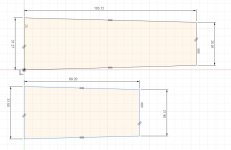I understand there are a few Wohlhaupter experts lingering in this section, but if I'm in the wrong spot, please feel free to redirect me.
Found an old UPA3 in a parts bin at work, nobody seems to recognize the shank, and I can't come up with any info anywhere I look. Hoping maybe somebody here recognizes it. Unfortunately it's the older style UPA3 without a removable shank, hence being in the parts bin to feed the newer replacements with R8's.
Taper is ~1.240"/31.5mm at the large end, 1.100"/27.9mm on the small end, over a distance of 2.724"/69.19mm. Threads are buttress type, with an OD of .775"/19.69mm. From any info I can find, that's oversized for 20mm buttress thread, to include the likely German sawtooth thread. Thread pitch is darn close to, but not quite 1.5mm. My Machinery's Handbook only has a couple pages on buttress threads, and I'm not finding much promise online.

Found an old UPA3 in a parts bin at work, nobody seems to recognize the shank, and I can't come up with any info anywhere I look. Hoping maybe somebody here recognizes it. Unfortunately it's the older style UPA3 without a removable shank, hence being in the parts bin to feed the newer replacements with R8's.
Taper is ~1.240"/31.5mm at the large end, 1.100"/27.9mm on the small end, over a distance of 2.724"/69.19mm. Threads are buttress type, with an OD of .775"/19.69mm. From any info I can find, that's oversized for 20mm buttress thread, to include the likely German sawtooth thread. Thread pitch is darn close to, but not quite 1.5mm. My Machinery's Handbook only has a couple pages on buttress threads, and I'm not finding much promise online.



 )
)



